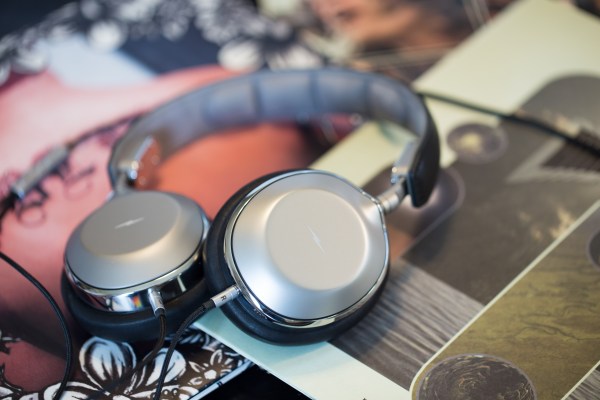The Shinola Canfield headphones cost $600 and do not ship with a stereo adapter. That should tell you everything you need to know. But if not, keep reading and let me explain why these fashion headphones are not worth the price.
I tested these headphones in a way that I thought they would be most widely used. I pitted them against several competitors using my iPhone 8 with Spotify. I also used an Onkyo stereo receiver with a Audio Technica turntable to test their upper limit. It was an enjoyable afternoon.
Before we get started, it’s important to note that I’m not a professional audio reviewer. I don’t have balanced power cables or a selection of FLAC tracks dedicated to testing equipment. But I do have a nice collection of headphones and a rather shitty taste in music. I don’t like a lot so I listen to the same stuff over and over. That’s annoying for passengers on road trips but handy when testing headphones.
The Shinola Canfields are the company’s first set of headphones. They’re built overseas, and tested in Detroit where Shinola also puts together watches and constructs leather goods. These come from America. Kind of. Let’s back up.
Shinola is a watch company born from the minds behind Fossil and launched as a marketing scheme out of Plano, Texas. The company set up shop in Detroit where it starting assembling quartz watches, adopting the Made In Detroit tagline. Later the company expanded to leather goods, bikes, and other products including turntables and now headphones.
Here’s the kicker: Shinola headphones are much like Shinola watches. They look fantastic. They’re heavy, solid, and feel like they’ll last a lifetime. They’re not worth the price. The appeal stops at the casing. The insides, much like Shinola watches, are comprised of low-end components, not worthy of the lofty price tag.
Review
I
found the Shinola Canfield headphones to be flat, tinny and bland. When used off an iPhone, the sound is underpowered and muddled. When used off a stereo amp, the sound is improved but still lacks the inflection and range of lesser-priced headphones.Classic rock is a great place to start with headphone reviews. First, the music is amazing, but second there’s generally a range of instruments with great soundstage separation. Carry on Wayward Son starts with a beautiful harmony of vocals followed by a couple quick hits on the snare and guitars. Through the $600 Canfields, the vocals are muddled together where on the $449 Audeze Sine headphones the soundstage opens up and there’s distinct separation that’s simply beautiful.
The dull vocals are even more evident in Pink Floyd’s Wish you Were Here. I have the original vinyl and it’s of course on Spotify, too, making it a great test track. The intro is long and classic Pink Floyd but it’s telling as a sample. Here I used the Audeze Sine headphones and the Massdrop-made Sennheiser HD 6XX headphones and the difference is stunning. Details are simply missing when the track is listened to through the Shinola headphones. The Shinola headphones did not reproduce David Gilmour’s smoker coughs and sniffles during the song’s intro; one cough sounds like shuffling papers. The sounds are clearly audible through the other headphones. When Gilmour finally starts playing, the Audeze headphones produce a stunningly clear guitar twang where the Canfields fall flat.
When this track is played through the turntable and amp, the differences are magnified. While the Shinola headphones sound better than when used with amp, the Sennheisers sound exponentially better and this track, and others like it, come alive.
Even when compared to Bose Quiet Comfort 35s, the Shinola Canfields come up short. The Bose headphones have a notoriously small range, but I use them a lot. I’m on a plane every few weeks. I put up with middle-of-the-road range because the noise cancelation is the best available. I threw Green Day on the turntable and loaded it on Spotify and found yet again, the Shinola headphones did not live up to their price.
I never found a music genre where the Canfields lived comfortably though they fared better with hip-hop than most. They do not have the soundstage or highs required by classic rock and jazz is a sloppy mess. It was hip-hop where they finally started sounding the part.
I turned on Flint’s homegrown Bootleg of the Dayton Family and the bassline surprised me. It was full though lacking the sheer power found in other headphones. Yet despite the lower power, the Shinola headphones were fine. I guess. It’s kind of hard to mess up hip-hop if the bass line is sufficient.
The Canfields stand out in one way, though. They look and feel amazing. They’re made out of leather, lambskin and stainless steel. The earpads are interchangeable and the headphones comfortably fit my big head.
The cans themselves are solid and thanks to the stainless steel are cool to the touch. These headphones feel like $600 headphones; I just wish they sounded like $600 headphones.
[gallery ids="1577204,1577202,1577199,1577206,1577203,1577200"]
Fashion over function
T
he Shinola Canfields are the Shinola watches of headphones. They feel great, come from Detroit and are overpriced.The sub-par performance could be overlooked if the price was more in line with other fashion headphones. At $600 these headphones are competing in the same space as products from Audeze, Master and Dynamic, and Grado — which is a fantastic family owned business out of Brooklyn in case there’s interest in supporting American-made products like Shinola.
I can’t see any reason to buy the Shinola Canfields besides the look. They really do look the part. But besides for fashion reasons, if you’re looking to spend $600 on headphones, I would highly recommend looking elsewhere.
